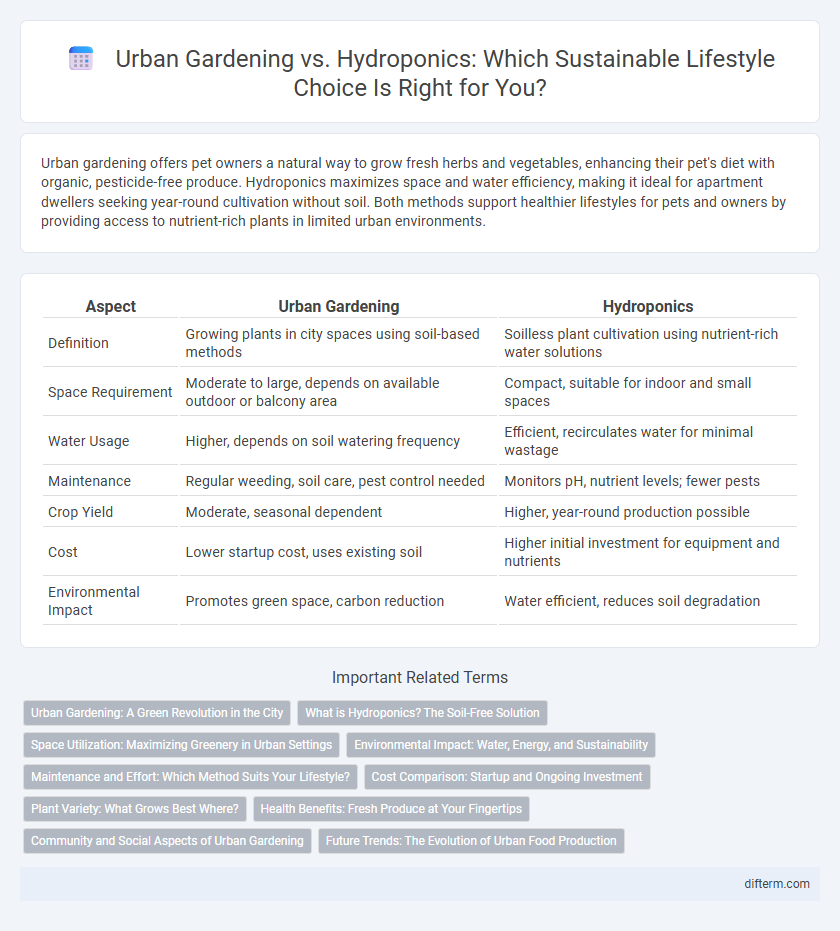Urban gardening offers pet owners a natural way to grow fresh herbs and vegetables, enhancing their pet's diet with organic, pesticide-free produce. Hydroponics maximizes space and water efficiency, making it ideal for apartment dwellers seeking year-round cultivation without soil. Both methods support healthier lifestyles for pets and owners by providing access to nutrient-rich plants in limited urban environments.
Table of Comparison
| Aspect | Urban Gardening | Hydroponics |
|---|---|---|
| Definition | Growing plants in city spaces using soil-based methods | Soilless plant cultivation using nutrient-rich water solutions |
| Space Requirement | Moderate to large, depends on available outdoor or balcony area | Compact, suitable for indoor and small spaces |
| Water Usage | Higher, depends on soil watering frequency | Efficient, recirculates water for minimal wastage |
| Maintenance | Regular weeding, soil care, pest control needed | Monitors pH, nutrient levels; fewer pests |
| Crop Yield | Moderate, seasonal dependent | Higher, year-round production possible |
| Cost | Lower startup cost, uses existing soil | Higher initial investment for equipment and nutrients |
| Environmental Impact | Promotes green space, carbon reduction | Water efficient, reduces soil degradation |
Urban Gardening: A Green Revolution in the City
Urban gardening transforms city spaces into vibrant green oases, boosting local food production and improving air quality. Techniques like container planting and vertical gardens maximize limited urban space, making fresh vegetables and herbs accessible year-round. This eco-friendly movement also fosters community engagement and mental well-being while reducing the carbon footprint associated with traditional agriculture.
What is Hydroponics? The Soil-Free Solution
Hydroponics is a soil-free gardening method that uses nutrient-rich water solutions to grow plants, enabling efficient space utilization and faster growth compared to traditional urban gardening. By delivering nutrients directly to plant roots in a controlled environment, hydroponics minimizes water usage and eliminates the need for pesticides. This innovative technique makes it ideal for urban dwellers seeking sustainable, high-yield food production in limited spaces.
Space Utilization: Maximizing Greenery in Urban Settings
Urban gardening leverages available outdoor spaces like balconies, rooftops, and small yards to cultivate diverse plant species, enhancing greenery within city environments. Hydroponics optimizes vertical space through soil-less systems, enabling dense plant growth in compact indoor or urban areas with minimal footprint. Both methods maximize greenery in urban settings by efficiently utilizing limited space, promoting sustainable and productive green living.
Environmental Impact: Water, Energy, and Sustainability
Urban gardening typically uses soil and can demand considerable water and land space, but promotes biodiversity and local ecosystems. Hydroponics employs nutrient-rich water solutions, drastically reducing water usage by up to 90% compared to traditional agriculture, and enables higher crop yields with less land. Energy consumption in hydroponic systems varies, often relying on artificial lighting and climate control, which can offset some sustainability gains unless renewable energy sources are integrated.
Maintenance and Effort: Which Method Suits Your Lifestyle?
Urban gardening typically requires regular soil preparation, watering, and pest control, making it ideal for those who enjoy hands-on outdoor activity and have flexible schedules. Hydroponics demands precise monitoring of nutrient levels, pH balance, and system cleanliness, suiting individuals comfortable with technology and consistent indoor maintenance. Considering the time commitment and technical skills needed helps determine which method aligns best with your lifestyle and gardening goals.
Cost Comparison: Startup and Ongoing Investment
Urban gardening typically requires lower startup costs, as it relies on soil, simple tools, and natural sunlight, making it accessible for beginners and small-scale growers. Hydroponics demands a higher initial investment due to the need for specialized equipment such as grow lights, pumps, and nutrient solutions, but it often results in faster plant growth and higher yields over time. Ongoing expenses in hydroponics include electricity and nutrient replenishment, while urban gardening's maintenance costs are generally limited to seeds, soil amendments, and occasional pest control.
Plant Variety: What Grows Best Where?
Urban gardening thrives with a broad range of plants such as tomatoes, peppers, herbs, and leafy greens that adapt well to soil-based container environments. Hydroponics excels in cultivating fast-growing, water-loving crops like lettuce, spinach, basil, and strawberries due to its nutrient-rich water solution and controlled conditions. Understanding these distinctions helps gardeners optimize plant variety and yield based on their available space and resources.
Health Benefits: Fresh Produce at Your Fingertips
Urban gardening and hydroponics both offer significant health benefits by providing access to fresh, nutrient-rich produce directly at home. Urban gardening enhances physical activity and mental well-being through soil contact and outdoor engagement, while hydroponics delivers faster growth cycles and higher yields of leafy greens and herbs without pesticides. Consuming homegrown vegetables from these methods reduces exposure to harmful chemicals and maximizes intake of vitamins and antioxidants crucial for a balanced lifestyle.
Community and Social Aspects of Urban Gardening
Urban gardening fosters strong community bonds by encouraging neighbors to collaborate, share resources, and exchange gardening knowledge, creating a shared sense of responsibility and achievement. Unlike hydroponics, which often takes place in controlled, indoor environments, urban gardens provide accessible green spaces that promote social interaction and collective well-being. These gardens act as communal hubs, supporting mental health and resilience by encouraging outdoor activities and fostering inclusivity across diverse urban populations.
Future Trends: The Evolution of Urban Food Production
Urban gardening is increasingly integrating smart technology and sustainable practices to enhance food security in densely populated areas. Hydroponics offers a soil-free, water-efficient solution that accelerates plant growth and maximizes yield, making it ideal for future city farms. Emerging trends highlight vertical farming and automated systems as key innovations driving the evolution of urban food production toward greater efficiency and environmental sustainability.
Urban Gardening vs Hydroponics Infographic

 difterm.com
difterm.com